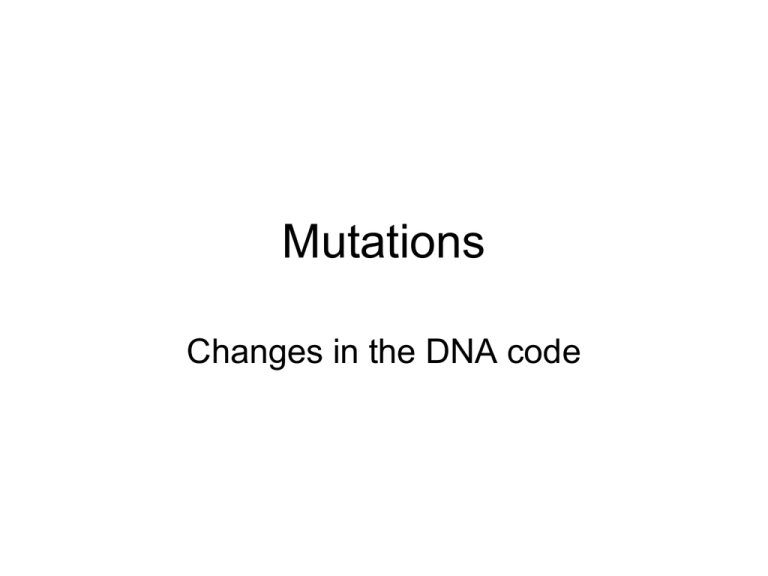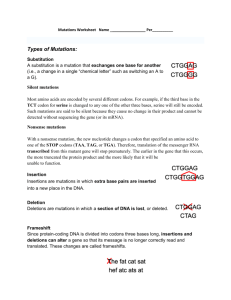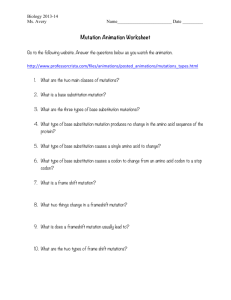Mutations
advertisement

Mutations Changes in the DNA code Mutation • A mutation is any change to the DNA. The can be as simple as a single base change (A to C) or as severe as deleting a whole section of the DNA. • The next pages give information on different types of mutations in genes and how they effect the proteins that they code for. Learning Objectives • What are the different types of mutations • Understand how each type effects the protein • Be able to identify different mutations from examples and predict their effect on the protein Table of Contents • Types of Mutations – Single Base Mutations • Point – Silent mutations – Missense – Nonsense • Frameshift – Addition – Deletion • Chromosomal Mutations – Inversion – Deletion – Translocation Point Mutation • A point mutation is a single change in the DNA nucleotide sequence. The change occurs when 1 base is substituted for a different base. • Another name for point mutation is single-base substitution • The picture above shows the last 5 codons of a wildtype or normal mRNA. In the normal protein the last four amino acids are methionine, lysine, phenolalanine, glycine. • A point mutation is a single base change. Find the base that changed & use the mRNA codon chart to see how it effects the protein. (Click on the picture below to check your answer) mRNA codon chart ? Silent Mutations • In this example, the amino acid did not change. If you look at the mRNA codon chart you will see that the 3rd base often has no effect on the amino acid. This is due to the wobble theory. • Mutations that have no effect on the amino acid sequence are called silent mutations Missense • In the example below, the mutation is still a point mutation since only 1 base is exchanged for another. • Find the base that changed & use the mRNA codon chart to see how it effects the protein. (Click to check your answer) ? mRNA codon chart Missense • When a mutation occurs in the 1st or 2nd letter in a codon it always changes the amino acid. • This type of mutation is called missense. Even though only 1 amino acid changed, many times this drastically effects the way the protein folds and works. • The inherited disease, sickle cell anemia, is an example of this type of mutation. Return Nonsense • The last type of point mutation is called nonsense. • Find the base that changed & use the mRNA codon chart to see how it effects the protein. (Click to check your answer) ? ? ? ? mRNA codon chart Nonsense • This last type of point mutation is called nonsense because it puts a termination (stop codon) in early, thereby cutting the amino acid sequence (protein) short. • This changes the protein structure and will most likely prevent the protein from doing its job at all. Return Point Mutation Self Quiz 1. Determine the mRNA and amino acid sequence for the strand of normal DNA. 2. Determine the mRNA and amino acid sequence for the mutated strands of DNA. 3. Compare the mutated strands to the normal strands. 4. Identify the type of mutation which has occurred. Normal DNA sequence • ATGTTGGCTTTACGGATTTTGA • TACAACCGAAATGCCTAAAACT <--codes for protein (template) • mRNA= • Protein sequence= • Notice that the DNA sequence above is double standed, but only the bottom strand is copied into mRNA • Click here to check your answers Normal DNA sequence Answers • ATGTTGGCTTTACGGATTTTGA • TACAACCGAAATGCCTAAAACT <--codes for protein (template) • mRNA= AUGUUGGCUUUACGGAUUUUGA • Protein sequence= met-leu-ala-leu-arg-ile-leu…. • Notice that the DNA sequence above is double standed, but only the bottom strand is copied into mRNA Mutant DNA •Normal DNA: •ATGTTGGCTTTACGGATTTTGA •TACAACCGAAATGCCTAAAACT • ATGTTGGCCTTACGGATTTTGA • TACAACCGGAATGCCTAAAACT <--codes for protein (template) • mRNA = • Protein sequence= • Compare this DNA sequence to the normal DNA. – Show where the change occurs. – What is this type of mutation called? – Did this change cause the polypeptide sequence to change? – Possible consequence for the organism= Mutant DNA #1 Answers • ATGTTGGCCTTACGGATTTTGA • TACAACCGGAATGCCTAAAACT <--codes for protein (template) • mRNA = AUGUUGGCCUUACGGAUUUUGA • Protein sequence= met-leu-ala-leu-arg-ile-leu…. • Compare this DNA sequence to the normal DNA. – Show where the change occurs. In red above – What is this type of mutation called? Point mutation: silent – Did this change cause the polypeptide sequence to change? No – Possible consequence for the organism= None Frameshift Mutations • Frameshift mutations cause the reading frame of the codons to shift. This is caused by the addition or deletion of one or more nucleotides. • When this occurs in a gene, usually the result is such a drastic change to the protein structure that the protein cannot work at all. Frameshift Mutations • An example of the shifted reading frame that occurs from a deletion can be seen in the sentence below: – Original sentence: The fat cat ate the wee rat. – Frame shift mutation: The fat caa tet hew eer at. • In the example sentence, a single letter was deleted and this shifted all the letters after that point. • This results in a missense protein that will probably not be able to fold correctly. Frameshift Self Check • For the two examples on the following pages determine the following: – Addition or deletion – Use the mRNA chart to see how the amino acid sequence is effected – Predict whether the changes will have no effect, minor effect, or major effect on the proteins structure and ability to do its job. Frameshift Self Check ? ? ? #1 #2 ? ? ? (Click to check your answer) ? mRNA codon chart Frameshift Self Check #1 mRNA codon chart #2 #1: Deletion causing missense. Major effect #2: Addition causing nonsense. Major effect Important to note that these are just examples. Both types of frameshift mutations can cause either missense or nonsense. Both of these will most likely have a major effect on both the protein structure and its ability to do its job. Chromosomal Mutations • Chromosomal Mutations are due to major changes in the DNA. Click on the picture below to see an animation of the 3 types of chromosomal mutations Quic kTime™ and a TIFF (Unc ompres sed) dec ompres sor are needed to see this pic ture. Quic kTime™ and a TIFF (Unc ompres sed) dec ompres sor are needed to see this pic ture. http://staff.tuhsd.k12.az.us/gfoster/standard/bmut.htm#one Quic kTime™ and a TIFF (Unc ompres sed) dec ompres sor are needed to see this pic ture. • The sentence below is an example of a chromosomal mutation. Identify which of the 3 types it is. – Original : The fat cat ate the wee rat. Inversion – Mutation: The fat tar eew eht eta tac. (Click for answer) Effect of Mutations • In all cases that we looked at, the mutations effected the protein itself. However, there are many types of mutations that do not change the protein itself but change • where and how much of a protein is made. – Type of cell that makes the protein – Too much or too little of the protein is made • When a protein is made – made at the wrong time Read and make notes on mutations and causes of mutations 262- 265 Learning check - #19 - 24









